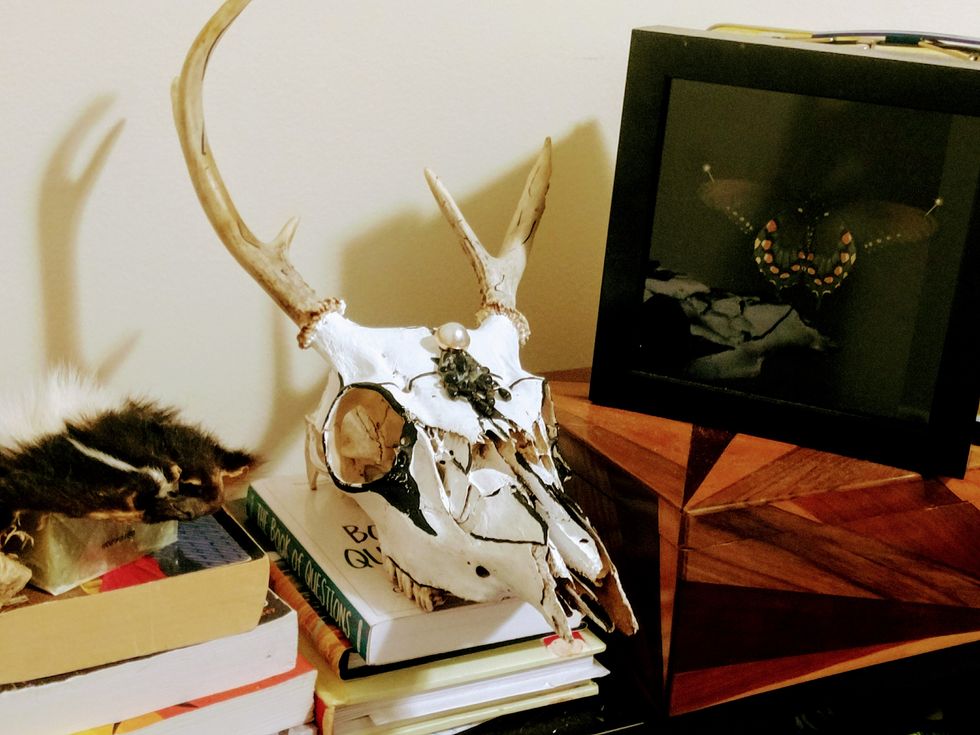Walking into my college dorm room can be a bit surprising for the uninitiated. Dead insects occasionally litter the dining room table. A deer skull sits on my desk, staring blankly at the room with empty eye sockets; next to it lies a soft mount of a skunk’s face. And my refrigerator and freezer are the current resting places of more than one animal corpse.
No, I’m not a budding serial killer, as bad as all this might sound. I’m an artist.
...One who just happens to have an eye for the morbid, macabre, odd, and uncanny.
Nature is, after all, the world’s most divine sculptor, and like an engineer with the mechanics of an intricate machine, it’s impossible for me not to be fascinated by all the little bits and pieces that make up some of the world’s creatures. Even the most mundane of critters can become stunning when reduced to nothing more than a skeleton; each bone serves a unique and integral purpose, the twisting, interlocking columns of white reminiscent of marble, sculpted into precise and eye-catching forms.
Insects, too, carry an unusual beauty with them in their delicate, shimmering bodies, so effortlessly lifted into the air by wings appearing as light as crystal filaments, exoskeletons bearing hues and metallic sheens as brilliant as gemstones. And as we all know, the best way to display gemstones is by prominently featuring them in pieces of jewelry.
So, if you’re asking: yes, I wear bugs as jewelry. And I decorate my home with bits and pieces of animal bodies.
The art of the oddity has gained significant traction in recent years, whether it be from the increasing strangeness of avant-garde art to a fascination with the concept of mortality. Whatever the reason, the practice of collecting, curating, and creating pieces from otherwise undesirable detritus has gained something of a cult following - no pun intended.
On the premier online marketplace for handcrafted artistic goods, Etsy.com, a simple search of the word ‘oddity’ conjures results of everything from raw materials like bones, antlers, or preserved insects to unnerving sculptures, cataloged and mounted oddity pieces, and strange vintage fashion.
The practice even earned its own documentary/reality television series; "Oddities" first aired on the Discovery channel in November 2010 and follows the sales and acquisitions of Obscura Antiques & Oddities, a small, quirky shop in east Manhattan stocked entirely with bizarre and grotesque finds from around the world. The show is in its fifth season and approaching its seventh anniversary, a testament to its success.
In many ways, this hobby is a narrow subset of antiquing combined with taxidermy from amateur to professional skill levels. We look for material anywhere it could possibly lurk: estate sales, junk-filled thrift shops, sprawling antique malls, auctions, both the in-person and online eBay variety. By now, there’s a high enough demand within the community that there are entire trading and sales events arranged for vendors where they can peddle their wares to the public and their fellow oddity enthusiasts.
One of my friends and mentors, who prefers to be known only as R.R. (and the username ‘momsuglytruth’ on our shared online community), creates beautiful and unusual jewelry featuring bones and preserved animal pieces. She owns several varieties of her accent pieces in bulk, an aspect of her collection that awed me; this allows her to create duplicates of her designs, a small but significant advantage in the business.
“Honestly, [I’ve gotten them] just trading within the community of events I’ve met,” she explained in our online chat. “My best friend is in the oddities business and hosts events. It’s been a great way to network. And I vend in [Pennsylvania and] people out there seem to live and breathe this stuff.” I purchased a bundle of unused teeth from her recently, which included coyote canines and buffalo molars, all of which will find their way into my jewelry somehow.
R.R. is lucky enough to be able to buy and work with pieces that have already been harvested and cleaned, something of a saving grace for those of us interested in oddity collection and preservation. But for others, whether out of thriftiness (such as myself) or simply for the sheer enjoyment of practical involvement, the process of obtaining and preserving specimens is a bit more...hands-on, if you will.
The leader of this very same community, Austin M. (known as ‘Spez’ online) is in the second camp on this one. Austin has been collecting for over a decade, and he’s been preserving for the last four years - and he’s only 21.
“I currently own around 230 individual skulls. Of course, I have over 100 in my freezer waiting to be processed, so it’s hard to keep track,” he revealed. “Believe it or not, I know a few people with two or three times that...some private collectors can give small museums a run for their money.”
Some of his favorite skulls include a giant alligator gar, a Belgian draft horse, a record-breaking cougar, a grizzly bear, a giant forest hog, a hippopotamus and an African Lioness. “I started out getting the common things online; most collectors start out on eBay,” Austin explained. “Years later, I found out that there are special groups on Facebook for collectors. I joined [each and] every one I possibly could and became an active member of the skull collecting community.
“I’ve gotten the majority of my skulls from these groups of fellow online collectors. Other than online, I frequently go around to antique malls and flea markets. I also attend several large antique shows a year. I’ve found quite a few rarer pieces while hunting in person at these events, most notably the grizzly bear and giant forest hog.
“It’s always such an awesome feeling finding treasures in person,” he said. “I do occasionally look for skulls in forested areas or farmland when able, but I do not collect roadkill since it’s illegal in my state to do so.” Austin made sure to note that knowledge of local and state laws is vital for collectors so their hobby doesn't get them arrested. “Lastly, I get a lot of raw heads from hunters/trappers/roadkill collectors out of state.”
Austin’s collection is incredible standing alone, but it’s even more impressive when you take into account that he cleans and processes the majority of the skulls he owns. Most often he relies on the simple process of maceration to clean the viscera from the heads and transform them into beautiful, pristine skulls. However, while a basic technique, maceration is not for the faint of heart, as he explains in his post “The Skull Cleaning Guide #5”:
“Maceration is a fairly simply simple concept. It consists of placing a prepped skull in a tub of water and letting nature do its thing. Once in the container of water, the naturally occurring bacteria and microbes will break down the flesh leaving nice, clean bones on the bottom.
“These bacteria thrive in heat ...The warmer the water is, the more the bacteria will multiply and the faster the skull will be cleaned,” the guide explains. “In 90-100 degree weather, I’ve had skulls done in less than a week! On average, it takes 2-3 weeks during the summer months.” So the process is simple, quick, and largely nothing but a waiting game; what exactly about macerating makes it difficult? Austin doesn’t sugarcoat it:
“There are a few disadvantages … The biggest one being the incredibly putrid smell. I don’t care what anyone says, if they haven’t smelled death then they can’t say that anything smells bad. It will make you gag. It still makes me gag every once in awhile and I’m used to the stuff.” His advice? “I highly recommend you wear a respirator until you’re comfortable with the smell.”
He was inspired to start his collection in a simple souvenir shop. “When I was about 7 years old, I and my family went on vacation to Florida. I remember walking into one of the hundreds of souvenir shops and finding rows upon rows of alligator heads,” he said in our online chat. “Of course, I bought one (what I consider the first piece of hundreds). I bought it to my school’s show and tell, and everyone marveled at it like it was some relic that had been lost to time. I enjoyed that feeling of having something ‘different’. I decided there that I wanted to own these things that most people considered ‘odd’.” He boiled it down to a single sentence: “At the core of it, I enjoy the fact that I can hold in my hands the things that some people may never even see in their lifetimes.”
Personally, I was inspired to start producing art using found insect and animal parts by watching my family, though I’ve always had an interest in the natural world, as well as the strange and macabre (I’ve watched a few episodes of "Oddities" myself). In 2015, my father remarried, joining two incredible, weird families; my step-grandmother Vera Tracy, whom I call Granny, is no stranger to creating art using the odd and outlandish. She is a long-time collector of bits and pieces of animals, mostly to add to her sculptural pieces - she’s particularly fond of turtles and birds, especially pelicans. However, it was my step-sister Pippin Long whose work first caught my attention in earnest.
While Long is not the type of artist to typically use dead material in her pieces, in 2014 she undertook the project of macerating an entire deer carcass she’d spotted on the roadside. Due to its missing antlers - one cleanly sawed off, the other broken jaggedly - the current theory is that it was a hunting trophy used for harvesting the antlers, then dumped or lost on the side of the highway, where scavengers picked most of the body clean. Though a majority of the body had already decomposed with time, she used the maceration process to separate the bones she wanted from the tendons and clean the skull.
For months, the rotting corpse lay submerged in a wheelbarrow in her mother’s backyard, enduring the heat of a Tennessee summer as the remaining flesh sloughed away from the skeleton to create a lukewarm soup of decomposition that festered nauseatingly day after day. But Long’s take on the experience isn’t all bad. “It wasn’t as gross as I was expecting,” she told me. “Obviously the smell was really bad, but it was weirdly beautiful to see the inner workings of a body.”
I’m thankful that at the moment I work almost exclusively with insects; while such specimens do produce a mild funk of decay, it’s much more tolerable than the scent of rotting, decomposing flesh. I’m certainly not a professional, as I’ve only pinned a single butterfly to date, primarily because I prefer the cruelty-free method of obtaining specimens which are already deceased, making new subjects for my creations few and far between.
I currently use a two-part resin mixture brushed over the insects’ exoskeletons as my preservation method; this strengthens the often brittle wings and gives the entire carcass a lovely high-gloss shine. Resin is an imperfect medium when it comes to preservation, and downsides to this method include the sticky mess it can produce and the potential for air pockets to form between the exoskeleton and the resin layer, causing it to dull and peel away. However, it is inexpensive and simple, making it the ideal choice for beginners focused on small projects.
Currently, I don’t actually hand-make my own jewelry bases, instead accessorizing existing jewelry with my work to modify it. My cicada shell earrings are the most complete piece to date, though I do have plans to create a fastener hairpin from a dragonfly in my possession, encase a beautiful June bug in resin to use as an amulet on a necklace, and craft some earrings from two butterfly wings I own. My ultimate goal is to remove the stigma surrounding the end of the life cycle in natural creatures and instead celebrate the beauty they possessed in life by creating pieces that showcase the most stunning aspects of their biology.
If you think this hobby seems slightly unhinged, well, so am I.
Taking the strange, the unorthodox and the downright weird and making them things of beauty is part of a much bigger picture than just the world of oddity artistry; in the end, this reimagining of what society deems “pretty” is a message to all the freaks, the outcasts, the nerds and the ugly ducklings that they, too, have beauty worth celebrating. All we need to do is embrace our own oddities, and showcase them to the world with pride.
To see more of Austin’s collection, read his full skull cleaning guide, and meet other collectors and artists who share the hobby, download the Amino mobile app and join the “Skulls, Bones, and Oddities” community.
For a gallery of Pippin Long’s more tame pieces, visit PippinLong.com.

























